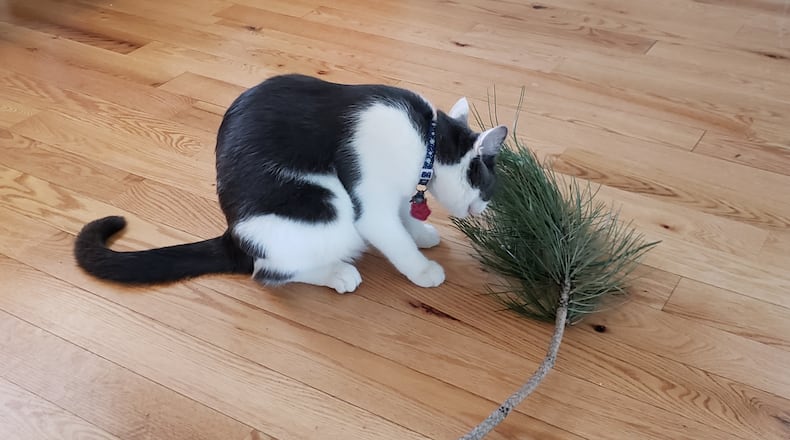His biology is designed for curiosity. Pip is somewhat of an expert, much more than his brother, Teddy, our 6-year-old Lab. According to cuteness.com, his curiosity also means he’s on constant alert, making sure everything in his world is in order.
When Pip walks into any room in our home, he scans the area. If there is something new, he will slowly, cautiously walk up to it. The cat will gently touch the object. If it appears harmless, Pip will continue to touch it as well as taste it, trying to figure out what it is.
If it really piques his interest, Pippin will bat it around with his front paws or pick it up with his teeth and carry it around the house.
Besides the purchased toys we’ve provided, such as wands, battery-operated bugs and tunnels, Pip has “found” toys throughout our house. These include large paper clips, ribbon and mini-craft pom poms.
To keep his curiosity going, we occasionally give the young cat an object from outside to examine. This spring we gave him pine cones, pine bows and interestingly-shaped rocks. All were on the smaller side as we tried to fit the items to his size. For example, the pine cones were similar in size to the pom poms he loves to bat around.
At first, Pip cautiously examines an outside object that we have placed on the floor. He’ll gently tap the item to see if it moves. Next, he’ll taste it. If interested, he’ll carry it all around the house, rub up against it, bat it back and forth and/or chew it.
With a small pine cone, he moved as close as one of his front paws could stretch and gently tapped it. When it didn’t move, Pip moved a little closer and tapped it again. Finally, when he was standing over it he bent down and picked the pine cone up with his teeth. He quickly spit it out. Apparently, it wasn’t tasty. But it was a good soccer ball. He started batting the pine cone all around the living room. The little pine cone has become a favorite toy.
We also gave him a small pine bow. Pip again slowly, almost methodically, touched it — first the branch and then the needles. The branch didn’t seem to interest him, but the needles did, at least for a few minutes. The cat touched the needles several times and then abruptly stopped, turned and walked away.
For a few hours, we left the pine bow on the floor but he never came back to it, so we picked it up. A few days later we put it back on the floor plainly in Pip’s view. He walked by it several times on his way to the master bedroom but ignored it.
As the seasons change, we’ll have more of nature’s objects to introduce to our curious Pip.
Karin Spicer, a magazine writer, has been entertaining families for more than 20 years. She lives in Bellbrook with her family and two furry animals all who provide inspiration for her work. She can be reached at spicerkarin@gmail.com.
Outdoor objects for indoor cats to explore
1. Nontoxic plants
2. Pine cones/stones (large enough that they cannot be swallowed)
3 Small tree branches
4. Leaves
5. Tree bark (monitor that the cat doesn’t digest any of it)
About the Author
